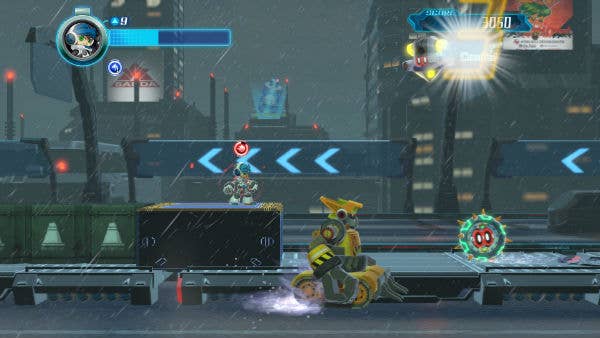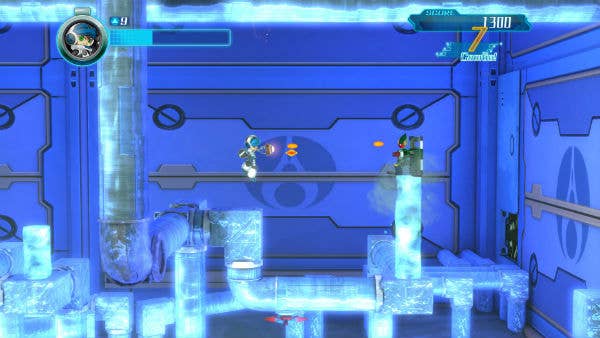Mighty No. 9 Xbox One Review: Mighty No-No
What gives, Inafune?
This article first appeared on USgamer, a partner publication of VG247. Some content, such as this article, has been migrated to VG247 for posterity after USgamer's closure - but it has not been edited or further vetted by the VG247 team.
Mighty No. 9 isn't the first high-profile game to suffer repeated delays. Legend of Zelda fans no doubt recall the agony of waiting for 1998's Ocarina of Time as it flitted from proposed release date to proposed release date like a fairy dancing in a field of flowers. But when we first wandered out onto the wide fields of Hyrule, we instantly realized the wait was worth it.
So when I was assigned to review Mighty No. 9, I decided I wasn't going to mention the game's troubled history. I figured if Keiji Inafune was truly on-track to deliver a successor to the Mega Man series, a few delays wouldn't hurt the game's prospects. After all, Capcom's in no rush to give us an official Mega Man game anytime soon.
Unfortunately, separating Mighty No. 9 from its tumultuous development is impossible. The game is haphazard, unpolished, and lacks anything close to the charm of Inafune's best-known Mega Man titles. As I slogged through tepid mid-tier platforming and tried not to let myself get distracted by the characters' inane chatter I found myself wondering where the hell all that extra time went, because it sure didn't go into playtesting or presentation.
Speaking of presentation, the single best word for Mighty No. 9's graphics is "dull." Its color palette relies mostly on greys and washed-out blues (with occasional stabs of electric purple courtesy of the game's many instant-death traps). Once in a while, you're treated to flashes of inspiration like a highway bathed in a blood-red sunset or a huge holding tank full of shimmering water. Most of the time, however, hero Beck plods through factories and mines that appear to be copy-pasted.

It may seem petty to ding an indie game for poor graphics, but Mighty No. 9's visuals are as unappealing as a bowl of cold chicken fat. You can open your mind wide as a window and you can tell yourself "graphics aren't everything," but you'll still be helpless not to notice how Dr. Sanda's lab is nothing but a blank blue wall and some piled-up boxes.
The character models don't emote. They don't move their mouths. They don't use any kind of body language when conversing. Their character portraits don't even change. Hilariously (or depressingly, depending on your viewpoint), Beck's "sister," Call, is supposed to be an emotionless robot who works exclusively by protocol, but her dead eyes reflect everyone else's.
By contrast, 1997's Mega Man Legends is certainly a primitive-looking game because of its low polygon count, but it more than makes up for its lack of prettiness by working with its weaknesses to give its world character. Reaverbots populate its ruins (all interesting despite their low-poly builds), bright colors decorate its towns, and characters' facial expressions illustrate the situation they're in.

Mighty No. 9's sub-standard presentation is especially saddening when you consider Inafune's plans to turn the game into a multi-media franchise. Inafune wants Beck and his family to be in manga, anime, and movies, but what's the point? The characters' stiff movements, awkward dialogue, and poor voice acting make it impossible for me to care about any of them. It's hard to believe Mighty No. 9's unlovable cast was created by the same man who gave us the mysterious loner Protoman, the bad-ass Maverick Hunter Zero, and the irrepressible Bonne brood.
In fact, long-time Mega Man fans will likely find themselves saying "Come on Inafune, you should know better" over and over while playing Mighty No. 9. The easiest way to point out how the game fails is by comparing it to Inafune's previous successes. For example, Mighty No. 4 is a construction robot who hangs out in a mine. Getting through said mine mainly involves dodging deadly tunnel-boring machines by ducking into crevices and then proceeding when the coast is clear. In the end, you take on a robot boss who travels in a straight line and rains down rubble on Beck. It's a serviceable level, but it's, well, boring.
It's also not Inafune's first time in the mines. 1993's Mega Man X likewise has a mine level. Its tunnel-boring machines are shaped like moles, and give up valuable secrets if you know how to maneuver around them or kill them. There are crazy rides on mine-carts that occasionally derail and send you flying over dips. There's a showdown with an armor-plated armadillo who careens off the walls with bone-shaking thuds. There's even an opportunity to learn how to fling Capcom's iconic Hadoken, and Dr. Light will teach it to you while sporting Ryu's karate gi.

Mighty No. 9's poor graphics are one thing. Its uninspired level design is another. But what really prompted my many explosive cries of "What the hell, Inafune?" while playing the game are the downright amateurish design flaws that pop up constantly.
The never-ending character chatter is the worst offender. It pelts against your sanity like tiny stones while you try to maneuver around danger. These aren't traditional cut scenes, which can be skipped. It's inane running commentary that gets in the way as you play. Sometimes literally, as text boxes tend to block platforms and ledges.
They can't be skipped. They can't be turned off. And when you die – which is inevitable – it happens all over again. Ironically, this chatter is supposed to endear you to Mighty No. 9's characters, but the repetitious interruptions cause you to wind up hating them.
Another example of poorly thought-out design lies in Mighty No. 8's stage, which charges you with hunting for its boss, Countershade. Countershade is by far the most interesting of the Mighty Numbers, and his stage design is certainly ambitious: Instead of going left-to-right as per usual, you travel freely through his hideout and chase him down. But like so many other ideas in Mighty No. 9, a seeming lack of playtesting hobbles any chance of fun the stage might offer. Countershade's stage is full of instant-death traps that are difficult to see until it's too late, and dying sends you back to Go.

Oh, and you have to listen to Countershade's dialogue every time you try again, by the way. I don't think I'd ever get sick of hearing Steve Blum's voice, but darn it Mighty No. 9, you came real close to tipping me over.
Mighty No. 9 is not completely bereft of merit. There are undeniably some cool ideas. The "Xel absorption" method of upgrading your firepower and defense is kind of neat once you get used to it, and as was mentioned earlier, the boss stages occasionally throw out a neat idea or cool trick. Maybe Beck will find his footing in Mighty No. 9's inevitable sequel. But for now, Mighty No. 9 looks and plays more like a term-end project for an upstairs game design college than anything that can be considered Mega Man's successor.
ConclusionMighty No. 9 contains the seeds of a good platforming franchise, but for now they're exactly that: Seeds. In its current state, Keiji Inafune's intended successor to the Mega Man series lacks creativity, joy, and character – not to mention several weeks' worth of polish.

